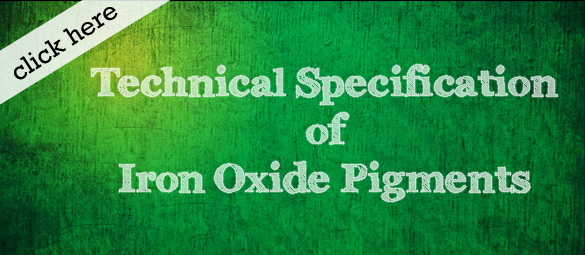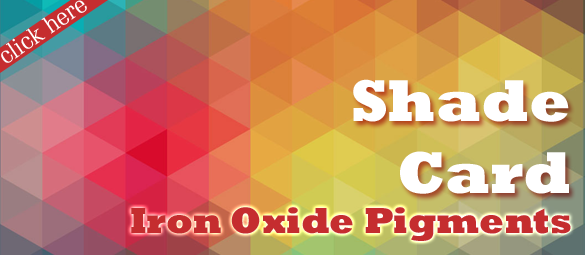Iron Oxide Pigments
Makes Life Colourful.
Iron Oxide
Iron oxide pigments are the most often used colour pigments in the world. They are available in the primary colours yellow (FeOOH), black (Fe3O4) and red (Fe2O3), but also as a mixture in orange, beige and brown shades.
The History Of Iron Oxide.
Iron Oxides have been used since prehistoric times (mainly the red shades). They were first used by cavemen to leave testimony of their presence in cave dwellings including animal drawings to ensure bountiful hunting. The first cave drawing was found in the Saubia Mountains (Germany), Lascaux (France) and Altamira (Spain). They were painted between 40,000 and 10,000 BC. Iron Oxide rich mineral clays provided the colors used. Iron Oxide was later found in Neolithic ceramic, Renaissance or Impressionist paintings, bricks of early cities, etc. Natural Iron Oxides are still used nowadays. However, synthetic types are much more popular nowadays because of their higher pigment performance. Their widespread use is due to their natural shade and outstanding chemical, physical and technical properties, which make them essential in many applications.
Key Attributes
| Range: | Iron Oxides |
| Sub-range: | Red Iron Oxides ( GO series) |
| Color Index | Pigment Red 101/C.I. 77491 (Iron Oxide Red) |
| Basic Chemical Composition | Fe2O3 |
| Dispersibility (*) | Excellent |
| Hiding Power/Opacity (*) | Excellent |
| Heat Fastness (*) | 800ºC, 5 min |
| Light Fastness (*) | Excellent |
| Weather Fastness (*) | Excellent |
| Acid Fastness (*) | Excellent |
| Alkali Fastness (*) | Excellent |
| Cement compatibility (*) | Excellent |
| Solvent Fastness (*) | Excellent |
| Metamerism (*) | No |
| Applications | Food Contact Packaging / Toys / General Packaging / Electric and Electronic Equipment / Automotive / Construction / Fertilizers / Plant Protection Products / Industrial uses / Artist Supply and Hobby preparations. |
Manufacturing Process
The Laux process

| Reaction of black: | 9 Fe + 4 C6H5NO2 + 4 H2O | 3 Fe3O4 + 4 C6H5NH2 | |
| Reaction of yellow: | 2 Fe + C6H5NO2 + 2 H2O | 2 FeO(OH) + C6H5NH2 | |
| Reaction of red: | 2 Fe3O4 + ½ O2 | 3 Fe2O3 |
Initially, the Laux process was exclusively used to manufacture aniline (C6H5NH2) from nitrobenzene (C6H5NO2). Only when in 1925 the chemist, Dr Laux, found out that the iron oxide, being a by-product of this reaction, could be used, subject to certain chemical conditions, as an iron oxide pigment with extremely high colour strength. This process is primarily used for black iron oxide (e.g. Black 330), however, the reaction to get iron oxide yellow (e.g. Yellow 420) is also possible. From black iron oxide, it is also possible to produce red iron oxide pigments (e.g. Red 110) in an additional reaction stage.
The Precipitation process

| 2 FeSO4 + 4 NaOH + ½ O2 | 2 FeO(OH) + 2 Na2SO4 + H2O |
In the precipitation process, iron sulphate is oxidized to yellow iron oxide pigment (Bayferrox® Yellow 920) in an alkaline environment with atmospheric oxygen. In this case, similar to the Penniman process, a yellow nucleus pigment is necessary in order to obtain yellow pigments of a high quality.
The Penniman process

| 2 Fe + ½ O2 + 3 H2O | 2 FeO(OH) + 2 H2 |
In the Penniman process, iron scrap is oxidized to yellow iron oxide (Bayferrox® Yellow 920) in a sulphate acid medium in the presence of atmospheric oxygen. In this case, iron sulphate acts as a catalyst. As to obtain yellow pigments of a high quality, yellow nuclei are furthermore necessary.
Eco - Friendly
Synthetic red, yellow, orange, brown and black iron oxides are non-toxic and made from 60% post-industrial recycled content processed .
Application
Iron oxide Pigments are widely used as inexpensive, durable pigments with large number of benefits and application around wide range of industries and products

